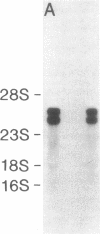Abstract
We have systematically investigated a genetic defect resulting in a primary lipoprotein lipase (LPL) deficiency in a proband TN and his affected brother SN, both manifesting familial hyperchylomicronemia. Neither LPL activity nor immunoreactive LPL mass was detected in postheparin plasma from the two patients. Immunocytochemical and biosynthetic studies on the proband's monocyte-derived macrophages with rabbit anti-human LPL antiserum revealed that no immunochemically detectable LPL protein was found in either the cells or culture medium, whereas LPL having a molecular mass of 61 kD was detected in normal cells. No detectable LPL mRNA was identified from poly(A)+RNA of the proband's macrophages by Northern blot analysis, and grossly visible LPL gene rearrangement was not observed by Southern blot analysis. Sequence analysis of polymerase chain reaction-amplified LPL gene exons detected one base deletion of G (first position of Ala221) at base 916 in exon 5 which leads to a premature termination by a frameshift. This mutation, designated as LPLArita and resulting in the loss of an AluI restriction enzyme site, was newly identified. We further analyzed the LPL gene from the two patients and their family members by digestion with AluI. Both patients were homozygous for LPLArita allele, while their spouses did not have this mutation. As genetically expected, their children were all heterozygous for LPLArita. We conclude that primary LPL deficiency in the proband was caused by a lack of enzyme synthesis due to the absence of LPL mRNA resulting from one base deletion of G in exon 5, and that heterozygous LPLArita deficient subjects show almost half value of control LPL mass.
Full text
PDF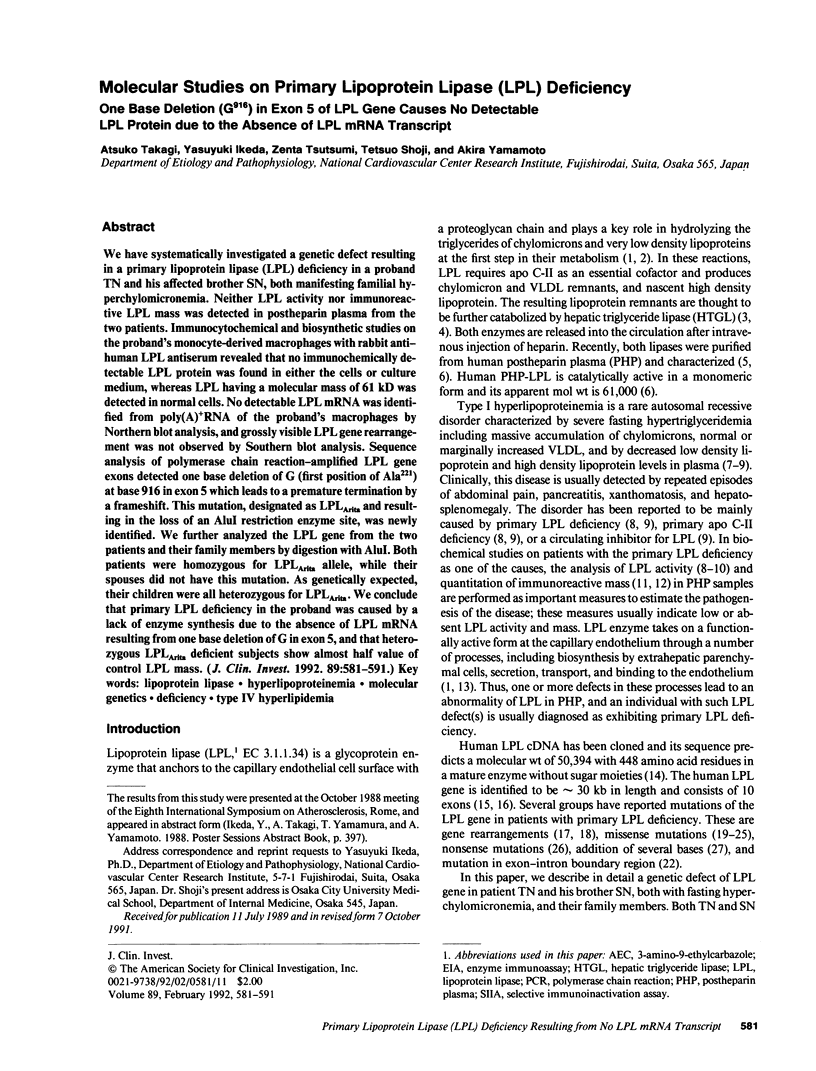
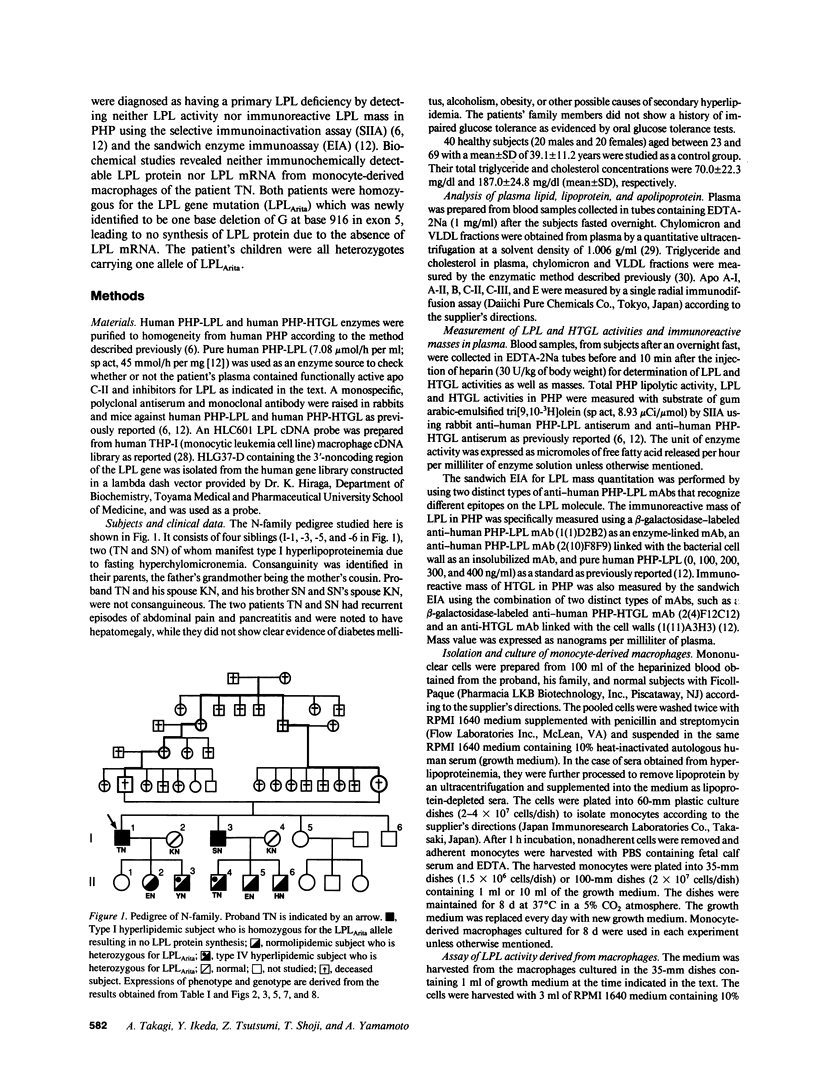
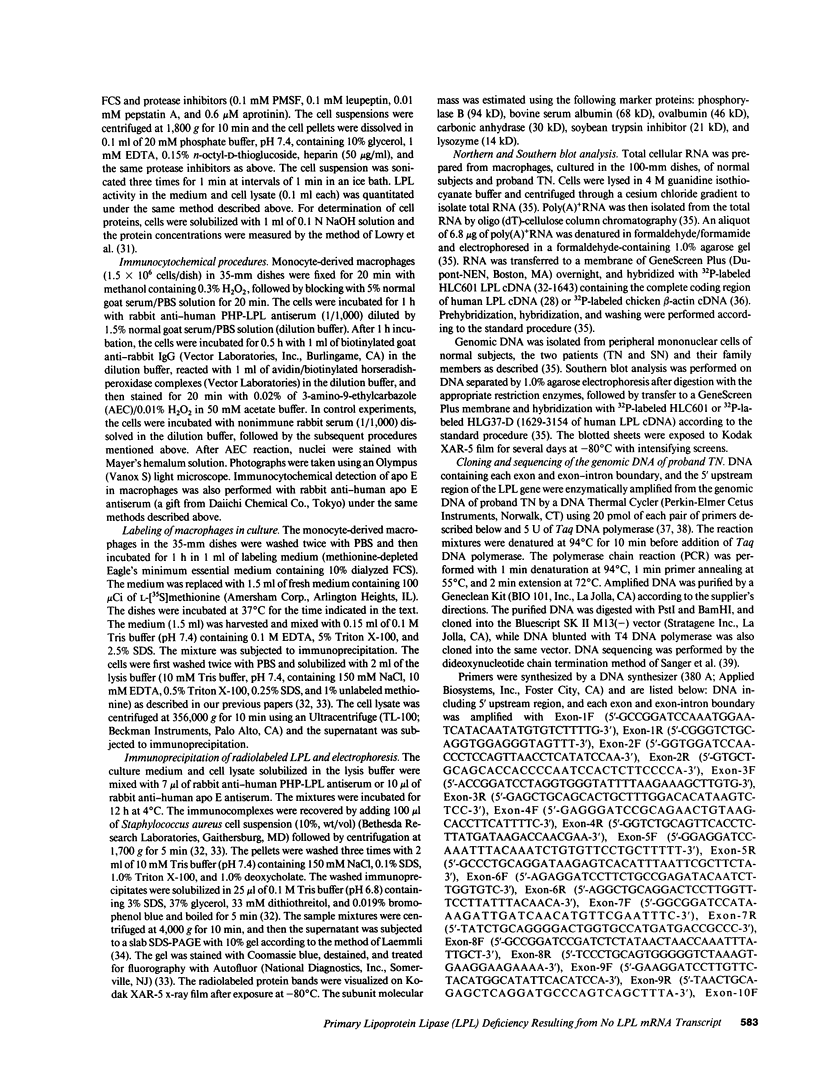
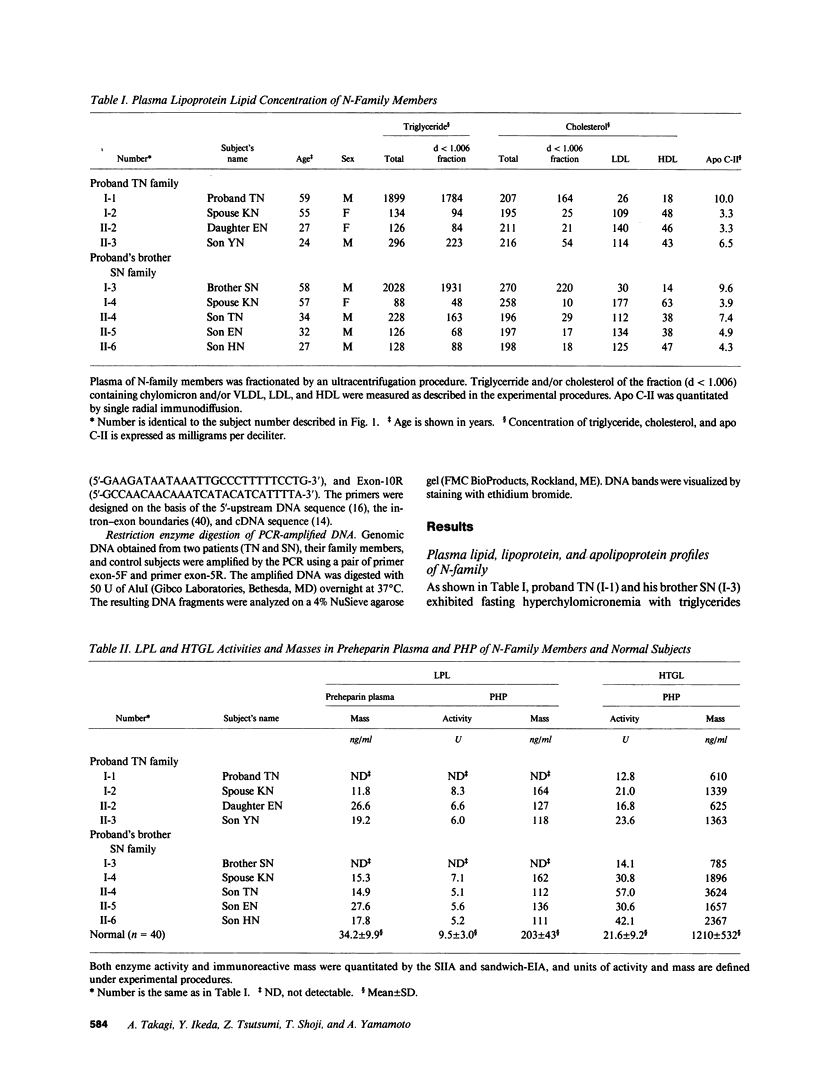
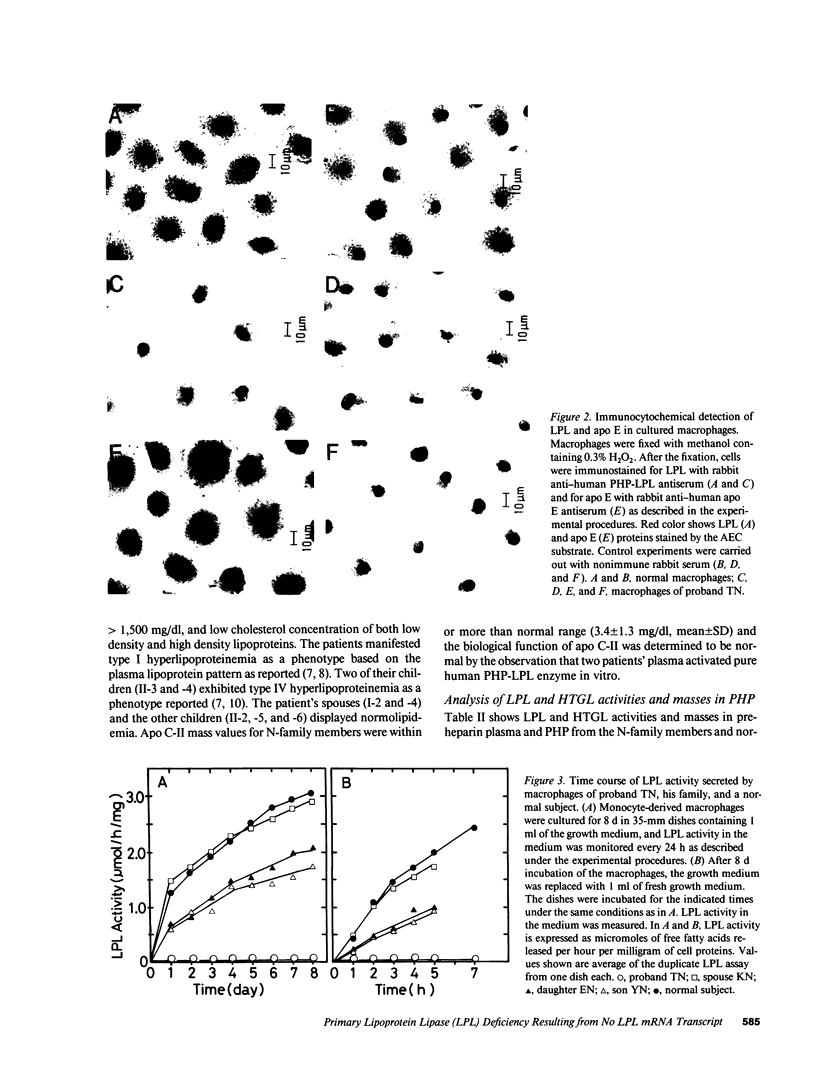
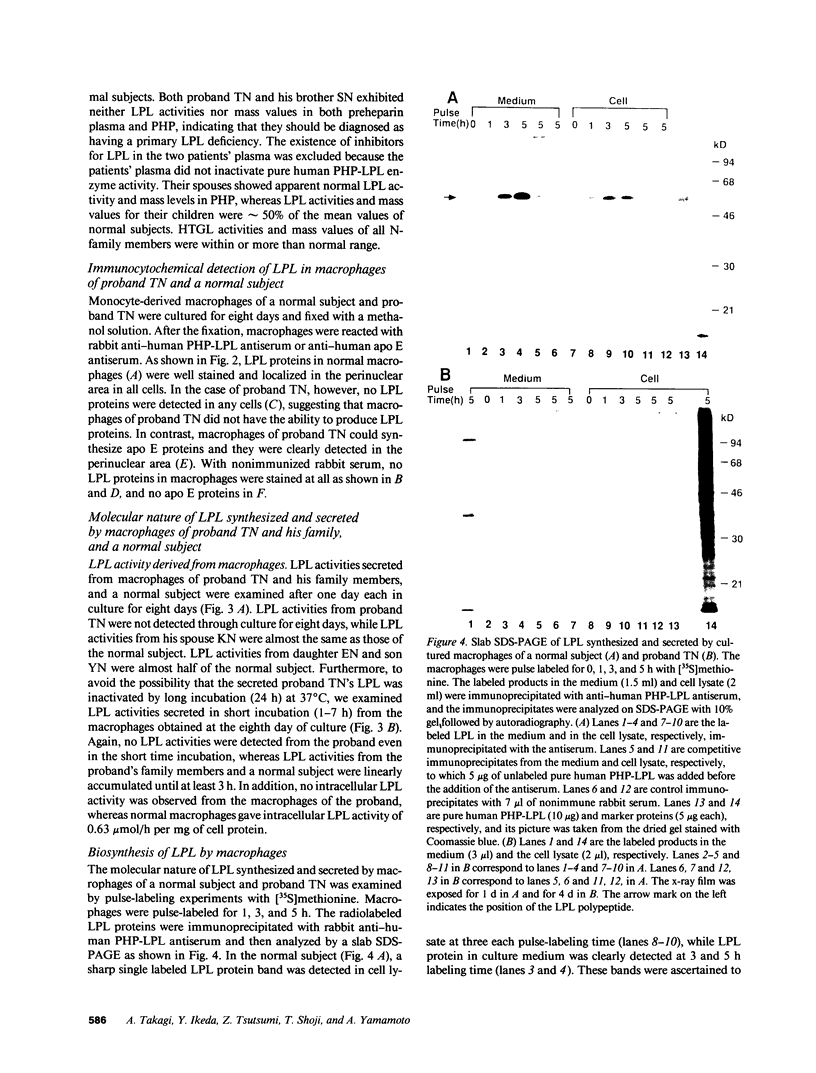
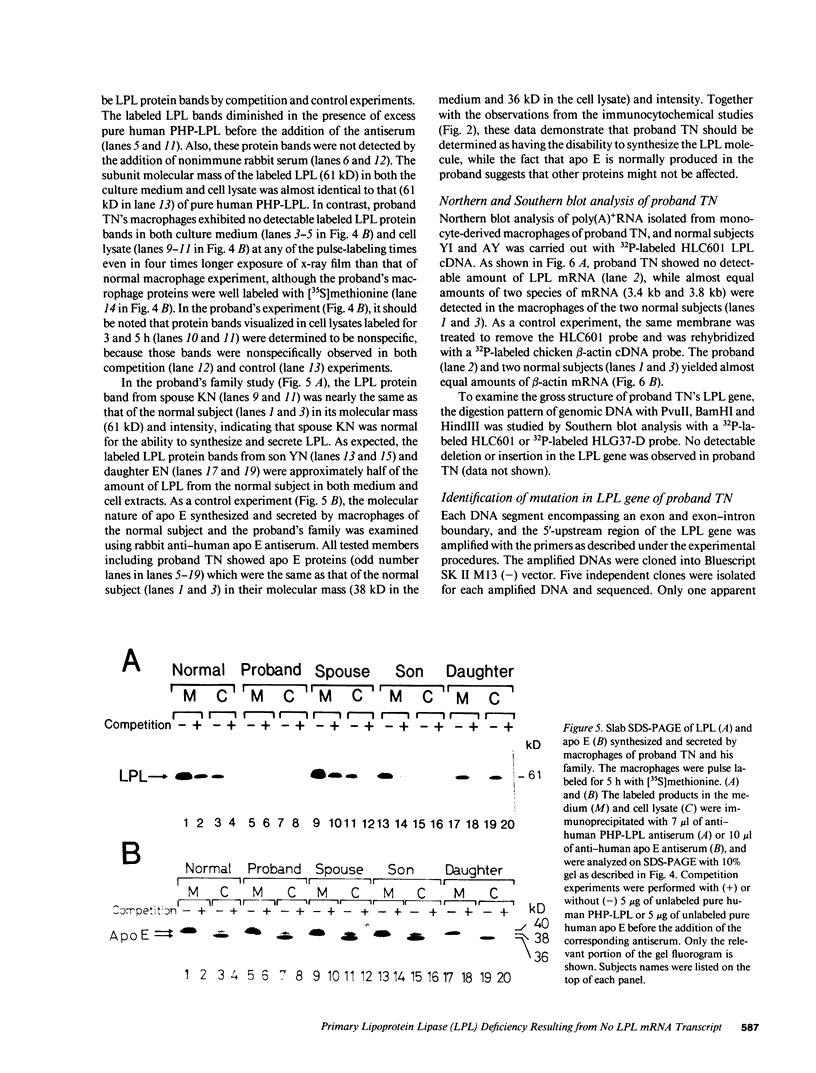
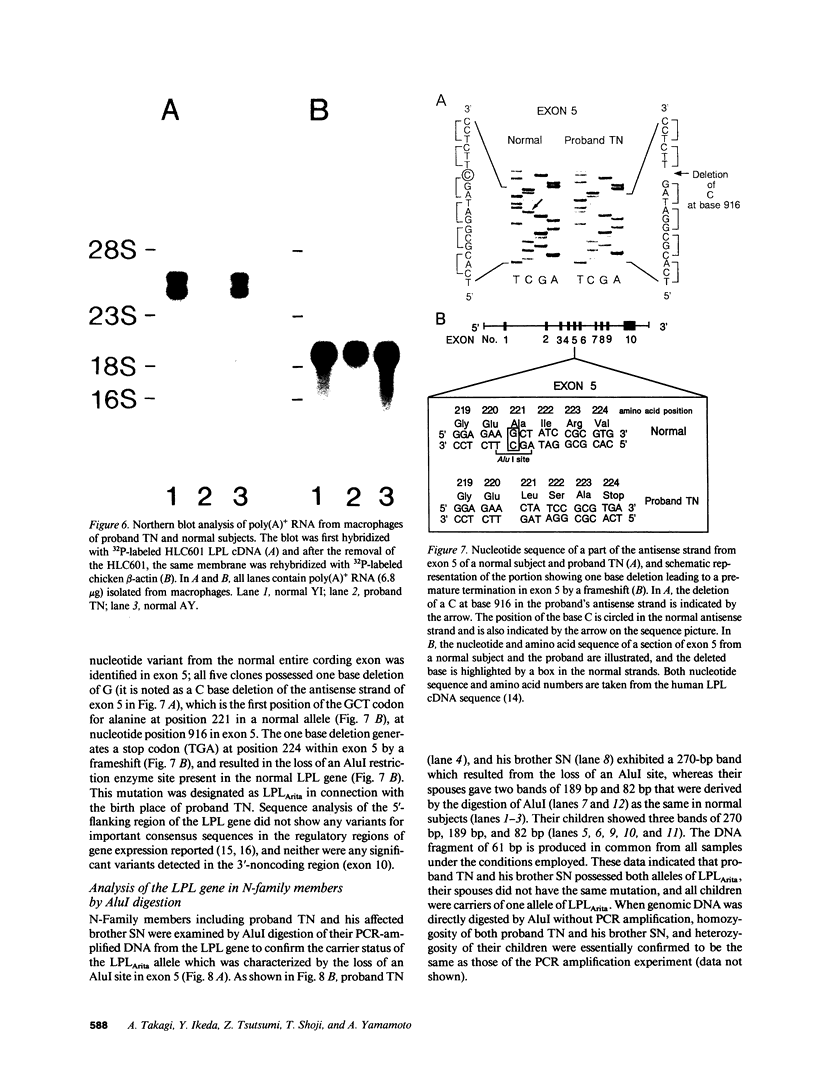
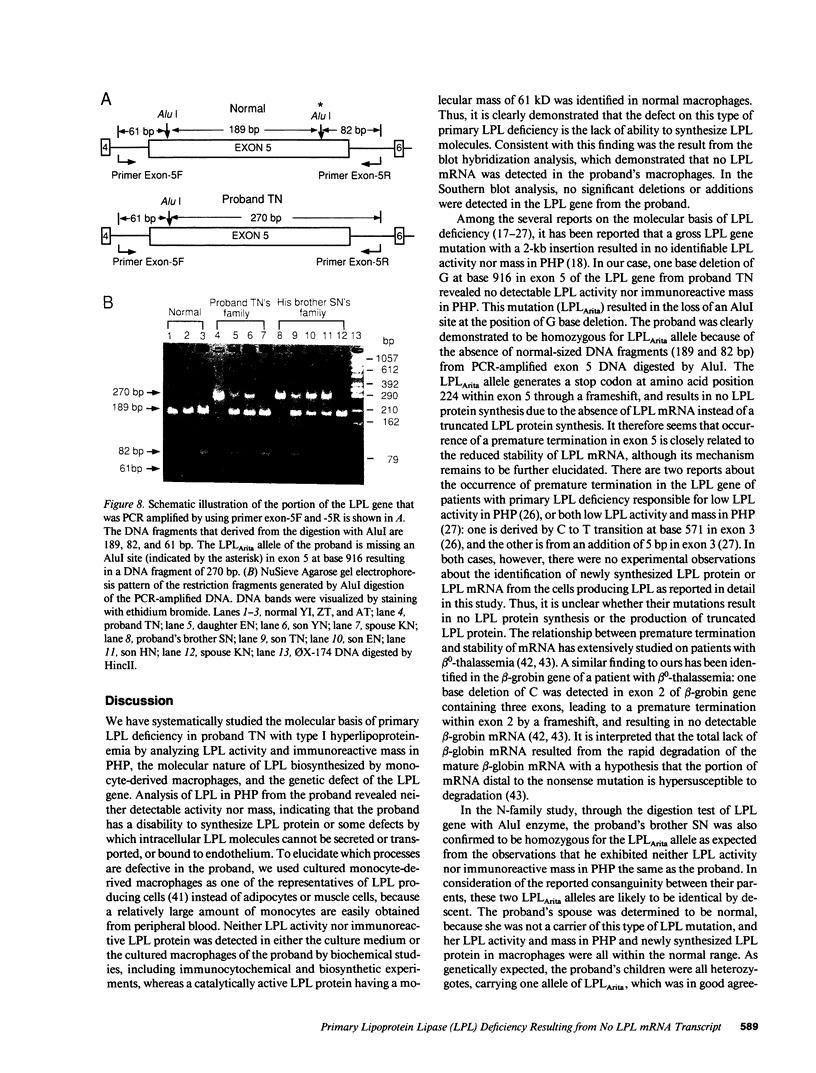
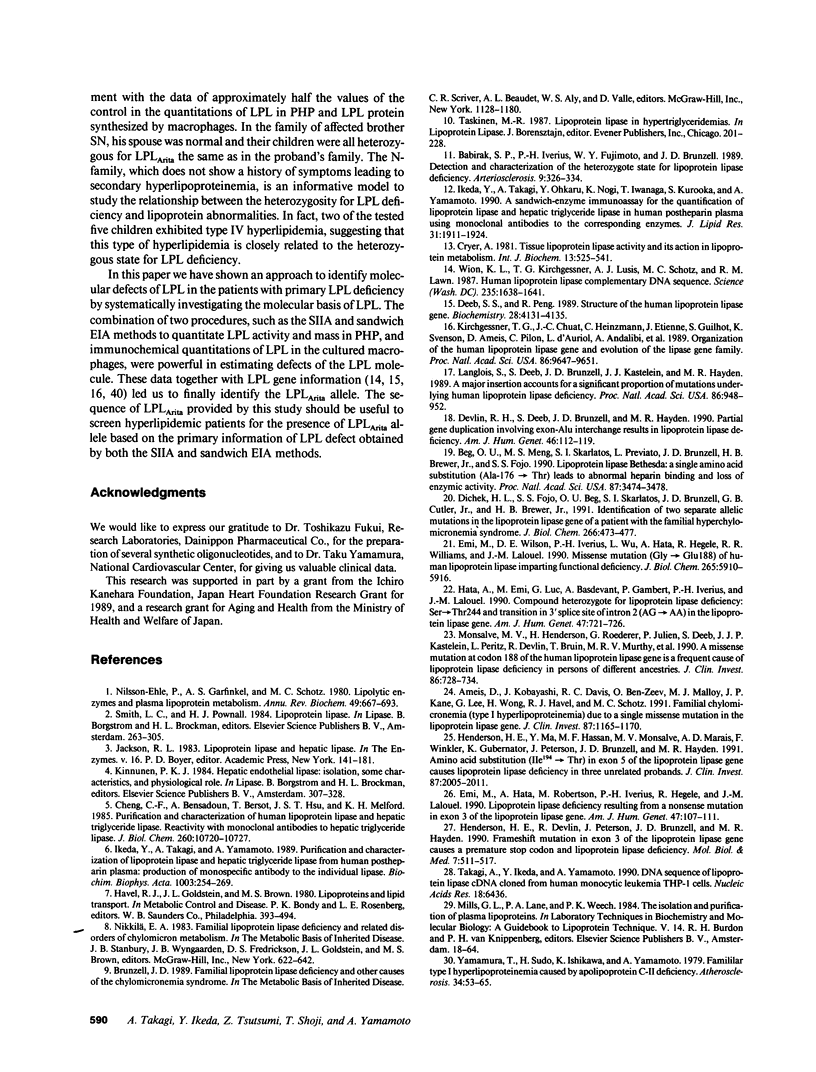
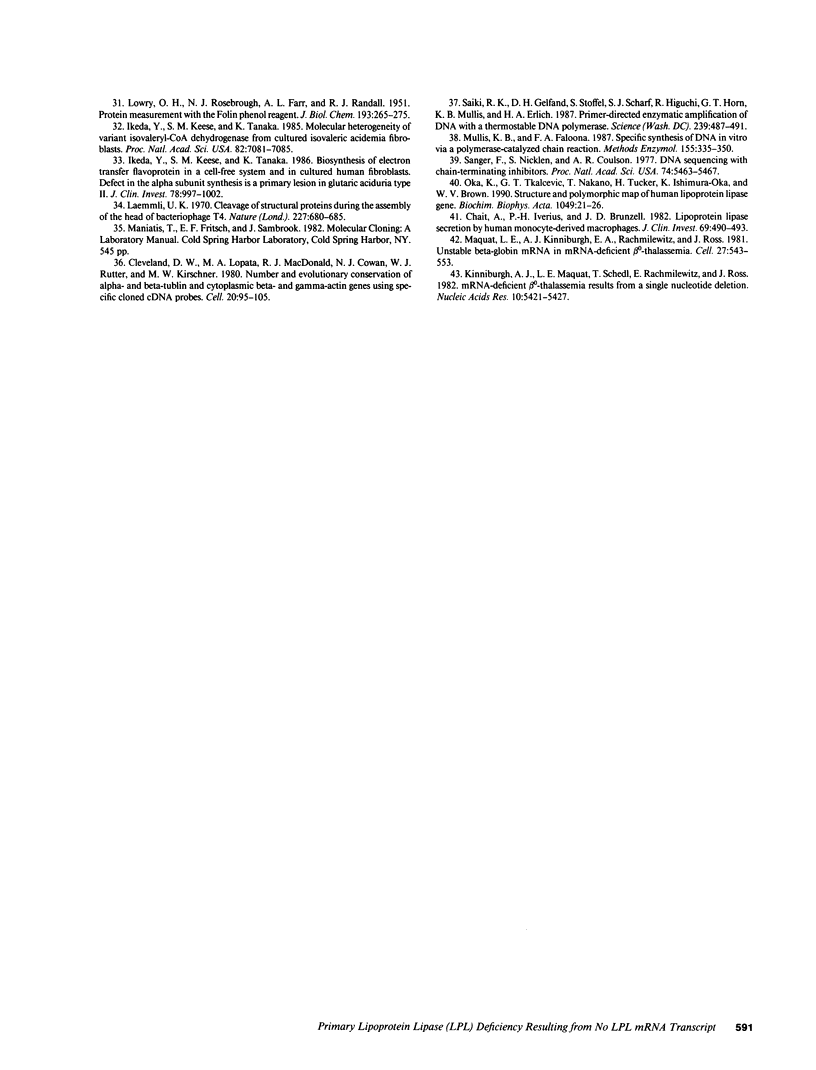
Images in this article
Selected References
These references are in PubMed. This may not be the complete list of references from this article.
- Ameis D., Kobayashi J., Davis R. C., Ben-Zeev O., Malloy M. J., Kane J. P., Lee G., Wong H., Havel R. J., Schotz M. C. Familial chylomicronemia (type I hyperlipoproteinemia) due to a single missense mutation in the lipoprotein lipase gene. J Clin Invest. 1991 Apr;87(4):1165–1170. doi: 10.1172/JCI115114. [DOI] [PMC free article] [PubMed] [Google Scholar]
- Babirak S. P., Iverius P. H., Fujimoto W. Y., Brunzell J. D. Detection and characterization of the heterozygote state for lipoprotein lipase deficiency. Arteriosclerosis. 1989 May-Jun;9(3):326–334. doi: 10.1161/01.atv.9.3.326. [DOI] [PubMed] [Google Scholar]
- Beg O. U., Meng M. S., Skarlatos S. I., Previato L., Brunzell J. D., Brewer H. B., Jr, Fojo S. S. Lipoprotein lipaseBethesda: a single amino acid substitution (Ala-176----Thr) leads to abnormal heparin binding and loss of enzymic activity. Proc Natl Acad Sci U S A. 1990 May;87(9):3474–3478. doi: 10.1073/pnas.87.9.3474. [DOI] [PMC free article] [PubMed] [Google Scholar]
- Chait A., Iverius P. H., Brunzell J. D. Lipoprotein lipase secretion by human monocyte-derived macrophages. J Clin Invest. 1982 Feb;69(2):490–493. doi: 10.1172/JCI110473. [DOI] [PMC free article] [PubMed] [Google Scholar]
- Cheng C. F., Bensadoun A., Bersot T., Hsu J. S., Melford K. H. Purification and characterization of human lipoprotein lipase and hepatic triglyceride lipase. Reactivity with monoclonal antibodies to hepatic triglyceride lipase. J Biol Chem. 1985 Sep 5;260(19):10720–10727. [PubMed] [Google Scholar]
- Cleveland D. W., Lopata M. A., MacDonald R. J., Cowan N. J., Rutter W. J., Kirschner M. W. Number and evolutionary conservation of alpha- and beta-tubulin and cytoplasmic beta- and gamma-actin genes using specific cloned cDNA probes. Cell. 1980 May;20(1):95–105. doi: 10.1016/0092-8674(80)90238-x. [DOI] [PubMed] [Google Scholar]
- Cryer A. Tissue lipoprotein lipase activity and its action in lipoprotein metabolism. Int J Biochem. 1981;13(5):525–541. doi: 10.1016/0020-711x(81)90177-4. [DOI] [PubMed] [Google Scholar]
- Deeb S. S., Peng R. L. Structure of the human lipoprotein lipase gene. Biochemistry. 1989 May 16;28(10):4131–4135. doi: 10.1021/bi00436a001. [DOI] [PubMed] [Google Scholar]
- Devlin R. H., Deeb S., Brunzell J., Hayden M. R. Partial gene duplication involving exon-Alu interchange results in lipoprotein lipase deficiency. Am J Hum Genet. 1990 Jan;46(1):112–119. [PMC free article] [PubMed] [Google Scholar]
- Dichek H. L., Fojo S. S., Beg O. U., Skarlatos S. I., Brunzell J. D., Cutler G. B., Jr, Brewer H. B., Jr Identification of two separate allelic mutations in the lipoprotein lipase gene of a patient with the familial hyperchylomicronemia syndrome. J Biol Chem. 1991 Jan 5;266(1):473–477. [PubMed] [Google Scholar]
- Emi M., Hata A., Robertson M., Iverius P. H., Hegele R., Lalouel J. M. Lipoprotein lipase deficiency resulting from a nonsense mutation in exon 3 of the lipoprotein lipase gene. Am J Hum Genet. 1990 Jul;47(1):107–111. [PMC free article] [PubMed] [Google Scholar]
- Emi M., Wilson D. E., Iverius P. H., Wu L., Hata A., Hegele R., Williams R. R., Lalouel J. M. Missense mutation (Gly----Glu188) of human lipoprotein lipase imparting functional deficiency. J Biol Chem. 1990 Apr 5;265(10):5910–5916. [PubMed] [Google Scholar]
- Hata A., Emi M., Luc G., Basdevant A., Gambert P., Iverius P. H., Lalouel J. M. Compound heterozygote for lipoprotein lipase deficiency: Ser----Thr244 and transition in 3' splice site of intron 2 (AG----AA) in the lipoprotein lipase gene. Am J Hum Genet. 1990 Oct;47(4):721–726. [PMC free article] [PubMed] [Google Scholar]
- Henderson H. E., Devlin R., Peterson J., Brunzell J. D., Hayden M. R. Frameshift mutation in exon 3 of the lipoprotein lipase gene causes a premature stop codon and lipoprotein lipase deficiency. Mol Biol Med. 1990 Dec;7(6):511–517. [PubMed] [Google Scholar]
- Henderson H. E., Ma Y., Hassan M. F., Monsalve M. V., Marais A. D., Winkler F., Gubernator K., Peterson J., Brunzell J. D., Hayden M. R. Amino acid substitution (Ile194----Thr) in exon 5 of the lipoprotein lipase gene causes lipoprotein lipase deficiency in three unrelated probands. Support for a multicentric origin. J Clin Invest. 1991 Jun;87(6):2005–2011. doi: 10.1172/JCI115229. [DOI] [PMC free article] [PubMed] [Google Scholar]
- Ikeda Y., Keese S. M., Tanaka K. Biosynthesis of electron transfer flavoprotein in a cell-free system and in cultured human fibroblasts. Defect in the alpha subunit synthesis is a primary lesion in glutaric aciduria type II. J Clin Invest. 1986 Oct;78(4):997–1002. doi: 10.1172/JCI112691. [DOI] [PMC free article] [PubMed] [Google Scholar]
- Ikeda Y., Keese S. M., Tanaka K. Molecular heterogeneity of variant isovaleryl-CoA dehydrogenase from cultured isovaleric acidemia fibroblasts. Proc Natl Acad Sci U S A. 1985 Oct;82(20):7081–7085. doi: 10.1073/pnas.82.20.7081. [DOI] [PMC free article] [PubMed] [Google Scholar]
- Ikeda Y., Takagi A., Ohkaru Y., Nogi K., Iwanaga T., Kurooka S., Yamamoto A. A sandwich-enzyme immunoassay for the quantification of lipoprotein lipase and hepatic triglyceride lipase in human postheparin plasma using monoclonal antibodies to the corresponding enzymes. J Lipid Res. 1990 Oct;31(10):1911–1924. [PubMed] [Google Scholar]
- Ikeda Y., Takagi A., Yamamoto A. Purification and characterization of lipoprotein lipase and hepatic triglyceride lipase from human postheparin plasma: production of monospecific antibody to the individual lipase. Biochim Biophys Acta. 1989 Jun 28;1003(3):254–269. doi: 10.1016/0005-2760(89)90231-2. [DOI] [PubMed] [Google Scholar]
- Kinniburgh A. J., Maquat L. E., Schedl T., Rachmilewitz E., Ross J. mRNA-deficient beta o-thalassemia results from a single nucleotide deletion. Nucleic Acids Res. 1982 Sep 25;10(18):5421–5427. doi: 10.1093/nar/10.18.5421. [DOI] [PMC free article] [PubMed] [Google Scholar]
- Kirchgessner T. G., Chuat J. C., Heinzmann C., Etienne J., Guilhot S., Svenson K., Ameis D., Pilon C., d'Auriol L., Andalibi A. Organization of the human lipoprotein lipase gene and evolution of the lipase gene family. Proc Natl Acad Sci U S A. 1989 Dec;86(24):9647–9651. doi: 10.1073/pnas.86.24.9647. [DOI] [PMC free article] [PubMed] [Google Scholar]
- LOWRY O. H., ROSEBROUGH N. J., FARR A. L., RANDALL R. J. Protein measurement with the Folin phenol reagent. J Biol Chem. 1951 Nov;193(1):265–275. [PubMed] [Google Scholar]
- Laemmli U. K. Cleavage of structural proteins during the assembly of the head of bacteriophage T4. Nature. 1970 Aug 15;227(5259):680–685. doi: 10.1038/227680a0. [DOI] [PubMed] [Google Scholar]
- Langlois S., Deeb S., Brunzell J. D., Kastelein J. J., Hayden M. R. A major insertion accounts for a significant proportion of mutations underlying human lipoprotein lipase deficiency. Proc Natl Acad Sci U S A. 1989 Feb;86(3):948–952. doi: 10.1073/pnas.86.3.948. [DOI] [PMC free article] [PubMed] [Google Scholar]
- Maquat L. E., Kinniburgh A. J., Rachmilewitz E. A., Ross J. Unstable beta-globin mRNA in mRNA-deficient beta o thalassemia. Cell. 1981 Dec;27(3 Pt 2):543–553. doi: 10.1016/0092-8674(81)90396-2. [DOI] [PubMed] [Google Scholar]
- Monsalve M. V., Henderson H., Roederer G., Julien P., Deeb S., Kastelein J. J., Peritz L., Devlin R., Bruin T., Murthy M. R. A missense mutation at codon 188 of the human lipoprotein lipase gene is a frequent cause of lipoprotein lipase deficiency in persons of different ancestries. J Clin Invest. 1990 Sep;86(3):728–734. doi: 10.1172/JCI114769. [DOI] [PMC free article] [PubMed] [Google Scholar]
- Mullis K. B., Faloona F. A. Specific synthesis of DNA in vitro via a polymerase-catalyzed chain reaction. Methods Enzymol. 1987;155:335–350. doi: 10.1016/0076-6879(87)55023-6. [DOI] [PubMed] [Google Scholar]
- Nilsson-Ehle P., Garfinkel A. S., Schotz M. C. Lipolytic enzymes and plasma lipoprotein metabolism. Annu Rev Biochem. 1980;49:667–693. doi: 10.1146/annurev.bi.49.070180.003315. [DOI] [PubMed] [Google Scholar]
- Oka K., Tkalcevic G. T., Nakano T., Tucker H., Ishimura-Oka K., Brown W. V. Structure and polymorphic map of human lipoprotein lipase gene. Biochim Biophys Acta. 1990 May 24;1049(1):21–26. doi: 10.1016/0167-4781(90)90079-h. [DOI] [PubMed] [Google Scholar]
- Saiki R. K., Gelfand D. H., Stoffel S., Scharf S. J., Higuchi R., Horn G. T., Mullis K. B., Erlich H. A. Primer-directed enzymatic amplification of DNA with a thermostable DNA polymerase. Science. 1988 Jan 29;239(4839):487–491. doi: 10.1126/science.2448875. [DOI] [PubMed] [Google Scholar]
- Sanger F., Nicklen S., Coulson A. R. DNA sequencing with chain-terminating inhibitors. Proc Natl Acad Sci U S A. 1977 Dec;74(12):5463–5467. doi: 10.1073/pnas.74.12.5463. [DOI] [PMC free article] [PubMed] [Google Scholar]
- Takagi A., Ikeda Y., Yamamoto A. DNA sequence of lipoprotein lipase cDNA cloned from human monocytic leukemia THP-1 cells. Nucleic Acids Res. 1990 Nov 11;18(21):6436–6436. doi: 10.1093/nar/18.21.6436. [DOI] [PMC free article] [PubMed] [Google Scholar]
- Wion K. L., Kirchgessner T. G., Lusis A. J., Schotz M. C., Lawn R. M. Human lipoprotein lipase complementary DNA sequence. Science. 1987 Mar 27;235(4796):1638–1641. doi: 10.1126/science.3823907. [DOI] [PubMed] [Google Scholar]
- Yamamura T., Sudo H., Ishikawa K., Yamamoto A. Familial type I hyperlipoproteinemia caused by apolipoprotein C-II deficiency. Atherosclerosis. 1979 Sep;34(1):53–65. doi: 10.1016/0021-9150(79)90106-0. [DOI] [PubMed] [Google Scholar]













